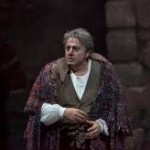It was fascinating. It was like walking into a dream. I felt like I was in a scene in the movie Phantom of the Opera. There was a dramatic transition: a transition from the present to the past with a chandelier rising, going from black and white to color. Running from the dark rainy city into a bright hall of excitement was a transition almost magical. Not only was I excited about my first opera experience, but felt the excitement flowing in the air as I walked through the Metropolitan Opera to watch Giuseppe Verdi’s Rigoletto.
The excitement continued even as I took a seat. Then it began. Again, like the movie, chandeliers rose up and lights went out. Even before the curtain was opened, the orchestra performed an overture. Conducted by Paolo Arrivabeni, the overture foreshadowed Rigoletto’s tragic plot. It served its purpose as expected; as a hook it grabbed my attention. Then it switched to a lighter, festive mood. Two most memorable parts of the orchestra was the beginning and the ending. Towards the end of Act 3, the orchestra creates the storm. Violins started getting more intense as the scene continued. The death of Gilda and revelation of Rigoletto was portrayed with more emotions aroused by the audience along with the sound effects.
Although I have enjoyed the orchestra very much, the vocals of the actors were most crucial in watching and enjoying the opera. First of all, I realized that I love the vocal range of a tenor. I was intrigued by Luciano Pavarotti’s previous performance of the Rigoletto and was hoping that Francesco Meli would not disappoint me in any way. I was not. His voice was pleasing to the ear and I was able to pay great attention when he was on stage singing. The soprano, however, performed by Christine Schafer was very new to me. The high notes she was able to hit were fascinating but because I was not used to it, I was uncomfortable in the beginning when listening to her first aria. However, as the opera continued I began to appreciate her vocal and her character more rather than feel unpleasant. By the third act her harmony in the quartet, “Bella Figlia Dell’amore”, was almost thrilling.
Another aspect I loved about the opera was definitely the stage itself. Lots of credit to Zack Brown, the set and costume designer. As the curtains went up, a recreation of a Duke’s palace was revealed. It was very believable. If there were any flaws, it was that the costume of the duke was not really distinguishable. If I had not read the program, I would not have known that the duke appears first. Even knowing so, it was hard to locate him on stage for the first few seconds. I feel that Gilda’s purity and innocence could have been depicted a bit better with the costumes; it seems that all she’s been wearing was a dress or a gown. However, the three different stages: palace, Rigoletto’s house, and Sparafucile’s house were all great in terms of portraying reality. Sets were all very believable in both size and the aesthetic aspects.
The final touch to the opera, along with the orchestra, the vocals, stage and costumes, was definitely the lighting. I love how the time of the day was depicted solely through the lighting. The highlight of the lighting effect was definitely the lightning during the storm. I was really intrigued by it. Lights flickered on and off at the background, streaks of lightning were depicted, and I was able to know that the weather is terrible even without the water drops or the dark clouds. Gil Wechsler was able to emphasize the mood of the finale.
My first opera ever, Rigoletto was very satisfying. In fact, it was more than satisfactory. Unlike what I thought before I even read the scenario, watching an opera was fun and exciting. It was a night to remember and Giuseppe Verdi’s Rigoletto, an all time classic, is highly recommended for everyone.




